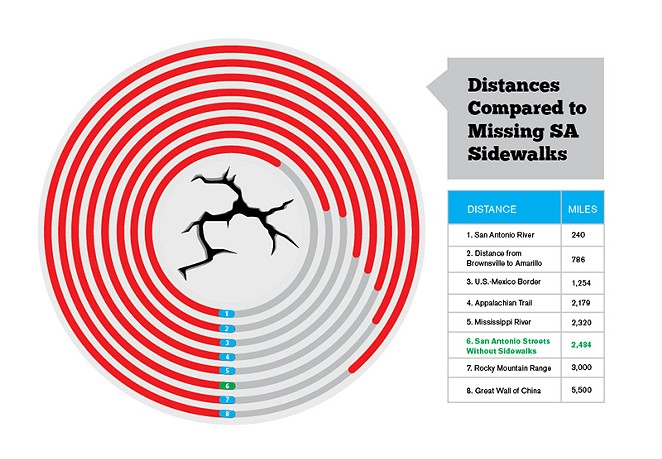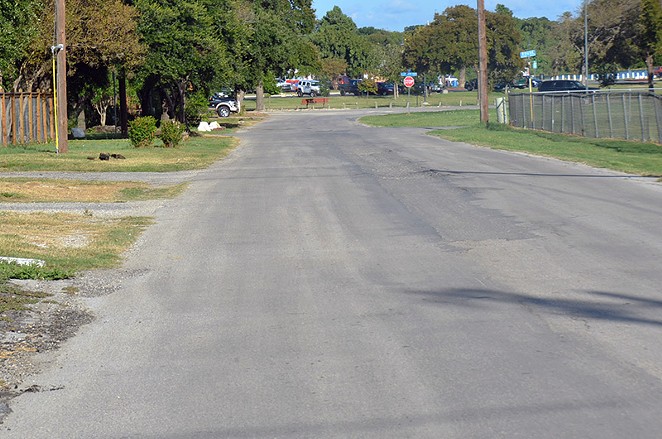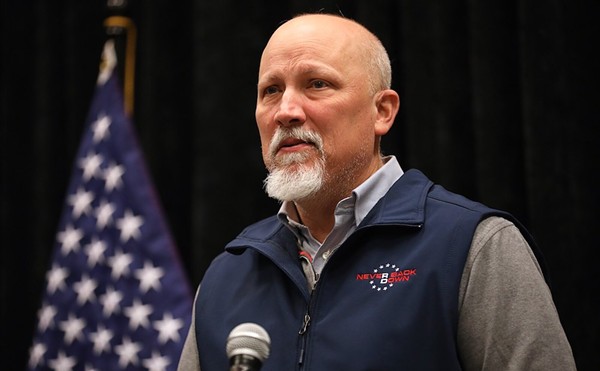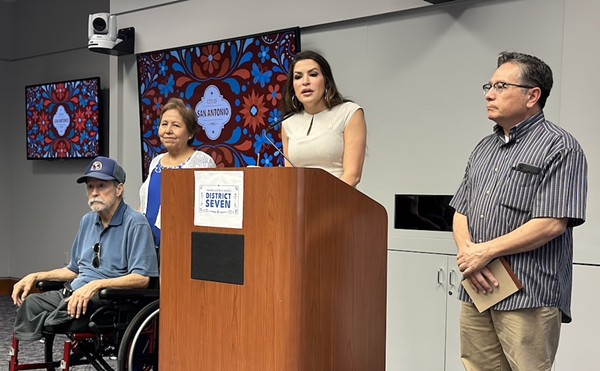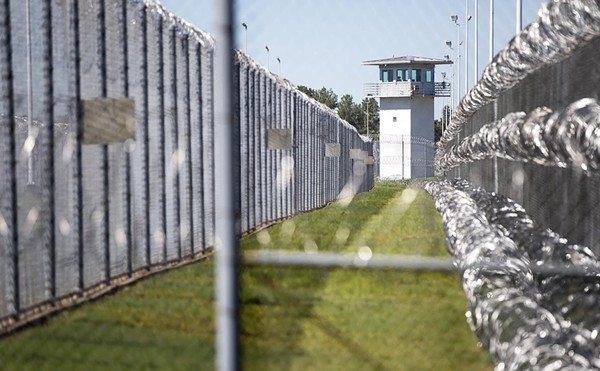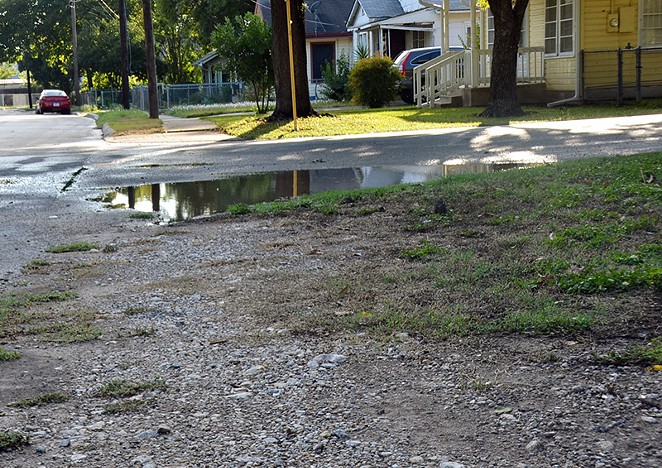
Depending on where you're going, traversing San Antonio by sidewalk is alternately difficult, dangerous or impossible.
Looking at the city's patchwork network of sidewalks from a bird's-eye view reveals an incomplete grid — like an old, shabby latticework fence in need of repair. Most San Antonio residents, particularly those who spend any time traveling on foot, have horror stories of how this manifests itself at ground level.
Slabs of pavement crumble and sink into the soil, or cleave sharply together like a little concrete peak. Sidewalks that stretch neatly through several blocks will suddenly vanish, only to reappear further down the street. Other places lack sidewalks entirely, creating a dank, marshy border of front yard and asphalt after it rains.
The problem disproportionately impacts the most vulnerable members of the population, such as those who can't afford their own vehicle and people with mobility impairments. But beyond the inconveniences and hazards, deficient sidewalks signal something more profound about the infrastructure inequalities around which San Antonio was built.
"In neighborhoods in the '30s, '40s or '50s, the neighborhoods that didn't have sidewalks were still mired in the mud like they were in the 18th century," said Char Miller, a former professor at Trinity University who studied the history of San Antonio's urban policies. "That signaled to those who had mud on their feet and mud in their kitchen as a consequence of heavy rain that they were thought of as nothing more than the mud they walked in."
For many, those same signals still ring loud and clear today.
Built-In Inequality
It's not as if San Antonio public works officials don't want to install sidewalks wherever they're needed. But they're playing catch up with limited funds, and fighting against decades of unfair practices and neglect.
As San Antonio slowly expanded in the mid-to-late 19th century, whether to construct sidewalks was a decision left to individual property owners. But, since they had to fund up to two-thirds of the bill, few did.
As the city annexed more subdivisions through the mid-20th century, few neighborhood developers chose to install sidewalks. With the rise of the automobile, some took pride in eschewing sidewalks, advertising themselves as a "new kind of suburb" for those who could afford to rely on their car, according to Miller.
The city largely used this "if you want it, pay for it" infrastructure model up to the 1970s. By then, a pattern was entrenched – sidewalks existed in places with sufficient money or political sway to install them. Everyone else walked in the mud.
"There's an inequality built into that process," Miller said. "The broader story is about public resources misspent, misaligned, and you can see the remnant of a segregated budget ... in the sidewalks."
Today, there are 4,769 miles of sidewalks in San Antonio, and almost 2,500 miles of roadway that lack sidewalks, according to the city's Transportation and Capital Improvements (TCI) department.
Those gaps are literally a billion-dollar problem, according to City Manager Sheryl Sculley. That's how much it would take to build sidewalks everywhere they're needed around town, Sculley said in an August budget briefing.
Councilwoman Shirley Gonzales, who represents much of the West Side, said her constituents ask her more about sidewalks than almost any other issue.
"It's a citywide problem but it's much more significant in the older districts," Gonzales said. "We are one of the oldest districts in the city, so we do have a tremendous need because some of the existing sidewalks are not functional. We're working on ways to try to improve that, to add as many sidewalks as possible."
That's clearly a priority for both regular citizens and city decision-makers.
When the City solicited public comments on the budget this summer, investing in sidewalks, streets and drainage projects emerged as the top priority.
San Antonio budget-makers listened. The newly approved budget for Fiscal Year 2016 allocates $15 million for sidewalks — almost double the amount budgeted for both 2014 and 2015.
The $15 million will pay for almost 31 miles of new sidewalks, according to Anthony Chukwudolue, assistant director for streets at TCI. At that rate, it will still take 80 years to install sidewalks everywhere they're needed. It's a drop in the bucket compared to the overall need, but it's a bigger drop than in previous years.
Buddy Villejo, a leader of the Service Employees International Union, called the increase "a good start." One of the group's greatest concerns is improving inadequate public infrastructure. It's a struggle that Villejo has observed throughout his 65 years living on the West Side.
"It's a bit irksome that we're not asking you to build another Alamodome on the West Side or some light rail. Just a little bit of concrete," Villejo said.
That's a refrain that Chukwudolue hears often. But between the crushing need and the few resources to fix it, he can often do little but ask people for their patience.
"Obviously we value every neighborhood in the city ... and we know we need to build out the network, but consider we have very little dollars with which to do this," Chukwudolue said.
To decide which stretches get sidewalks, TCI uses a scoring system that prioritizes areas around schools, hospitals, bus stops and community centers. It also considers patterns of where automobiles hit pedestrians.
'It's About Time'
While those who live in neighborhoods with nonexistent sidewalks suffer the most, the entire city shares the burden to a certain extent.
The lack of functional sidewalks pushes citizens to use their cars more often, which means they miss out on the health benefits of walking or biking. Pulling cars off the road would also improve the sub-par air quality in San Antonio, one of three Texas cities in non-compliance with the Environmental Protection Agency's ozone standards.
Willie Mae Clay knows the city's sidewalks better than most. Clay has a mobility impairment that requires her to use a scooter. It doesn't slow her down, but she has to be careful in certain parts of the city.
"As I travel on my scooter ... when you get further from the downtown area, that's where you run into problems," Clay said. "It's about time that someone focused on the areas that are economically deprived."
Clay is also vigilant about identifying violations of the Americans With Disabilities Act (ADA), the 25-year-old law that established accessibility standards for people with disabilities.
The cracks and gaps present tremendous hazards to someone like Clay. Sometimes the bus will drop her off in an area without a sidewalk, forcing her to grind through the grass to the nearest patch of cement.
Such problems are costly to fix, but ignoring them could be even more expensive, thanks to a recent landmark court decision.
In April, a federal court ruled that Los Angeles' lousy sidewalks violated the ADA. The city must spend more than over $1.3 billion over the next three decades to repair them.
Chukwudolue said that while he wasn't familiar with the specifics of that particular lawsuit, TCI considers ADA regulations in every project it undertakes.
But lawsuits aren't the only risks that inadequate sidewalks present. Councilwoman Gonzales is also spearheading an effort to eliminate one of their main symptoms: pedestrian deaths.
San Antonio officials recently announced they would participate in Vision Zero, an international initiative that sets rules and guidelines to eliminate pedestrian deaths. Multiple organizations, including Bexar County, area school districts and the Alamo Area Metropolitan Planning Organization will also take part in the effort.
In 2014, 54 pedestrians died in traffic accidents in San Antonio, the 18th-worst rate in the country. The goal of Vision Zero is to prevent all traffic fatalities. Improving the city's sidewalks is a crucial component to achieve that, Gonzales said.
"It's a critical part of the Vision Zero concept that we have safe streets and safe places for
people to walk. I think that a significant investment in repairing the sidewalks or putting them where they don't exist already should be a definite priority," Gonzales said.
Few would disagree with Gonzales' statement, but it's one that people in certain parts of the city have screamed for generations. The budget increase is a promising sign for people like Villejo and Clay. But they also realize that there is, quite literally, a long way to go.

